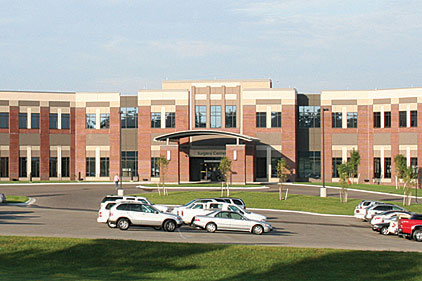
|
| When Geary Community Hospital in Junction City, KS, underwent a $34 million expansion, it successfully surpassed healthcare ventilation standards in part by employing UVGI systems and dedicated outdoor air dehumidifiers. |
When Geary Community Hospital (Junction City, KS) underwent a $34 million expansion, it was promised a cutting-edge HVAC design that would reduce maintenance costs, increase energy efficiency, and provide unprecedented IAQ. Three years later, the predictions have proven true based on reviews by Steve Rippert, the hospital’s director of maintenance.
“It’s incredible that a small town with only 25,000 people like Junction City, KS, now has the same technology you would typically expect only in large cities,” said Rippert.
One example of reduced maintenance is the 95,000-sq-ft expansion’s four air handlers and dedicated dehumidifiers, which haven’t needed coil cleaning during three years of monthly checks. This saves the hospital a minimum of $1,500 in annual cleaning costs, according to Rippert. It also adds to the much needed IAQ in the expansion’s critical environments, such as the 15,000-sq-ft surgery suite.
MEP consulting firm Henderson Engineers created a design team for the project led by Shane Lutz, P.E., LEED AP, BD+C, CHFM, principal; and Jared Wagner, P.E., LEED AP, BD+C, mechanical engineer. Although the HVAC system was anchored with a conventional four-pipe chiller and boiler loop concept, the IAQ technology is some of the most cutting edge healthcare strategies, according to the designers. In particular, the design surpassed ASHRAE Standard 170 — Ventilation of Health Care Facilities.
UVGI advantages
The hospital’s UVGI systems are from the Fresh-Aire UV Commercial Series by Triatomic Environmental Inc. They use 32-in UV lamps in modular racks affixed to the supply side of every coil. All the UV systems were field-installed into five air handlers.
Besides maintenance cost savings, UVGI also weighs heavily into each HVAC unit’s energy efficiency. Industry studies reveal that coils void of biological growth have unrestricted static pressure, reduced blower electric load, and optimum heat transfer. A thin growth of bio-film on coil surfaces can reduce the free area and increase air velocity up to 9%. Cleaner coils also deliver up to a 30% increase in cooling capacity when compared to dirty coils, according to Michael Wixson, principal with Associated Air Products, a manufacturer’s representative that assisted with the UVGI specification.
“We’ve seen the effects of no UV lights in older HVAC systems,” said Lutz, “and there’s a tendency for coil microorganism growth that you definitely wouldn’t want distributed throughout a critical environment such as OR or any other healthcare environment.”
UVGI alters the DNA and disables the reproductive capabilities of any microbe passing through its UV field in the air handler. Microbes later become entrapped in HEPA filters manufactured by Camfil Farr. Combined with each air handler’s 30% pre-filter and 65% filter, the HEPA filters’ 99.9% particle-free filtration delivers optimum IAQ.
Pinpoint temperature and humidity
What separates the expansion’s design from older healthcare designs, which typically use conventional air conditioning package units, is a dedicated outdoor air dehumidifier by Munters. The 100-ton unit cools and heats, but most importantly it dehumidifies the surgery suite air to the surgeons’ requirements, which is typically in the 30% to 50% rh range. Each OR has a standalone steam humidifier supplied by the central plant boilers to boost RH, if needed.
“Typically, 72°F and 50% rh is fine for most hospital areas, however surgeons wear gowns and it’s a high-stress area where perspiration isn’t acceptable,” said Wagner. “Therefore we specified a dedicated dehumidification unit for the surgery suite that surgeons can easily set for temperatures and rh such as 65°F and a 30% rh, which most conventional air-conditioners would struggle to achieve.”
Also integral to the OR’s IAQ are tight tolerances on pressurization, the prevention of untreated air infiltration into surgery areas, and 30 ach, the latter which surpasses healthcare standards by 100%.
Air terminal units with multi-point sensors on both supply and return ductwork allow the return airflow to track the supply airflow to maintain positive pressure in the rooms. Linear stainless steel ceiling Hospital Operating Room Diffusers (HORD) systems manufactured by Price Industries have two components — laminar diffusers that broadcast a gentle 25-fpm, non-turbulent airflow over the patient, and a perimeter linear curtain that encircles the OR’s staff and patient area with a protective air curtain barrier. Low return air grilles located symmetrically in the OR remove contaminated air and any heavier-than-air gases safely and effectively from the space.
The expansion’s Metasys building automation system manufactured by Johnson Controls monitors the suite’s environment as well as the as a new intensive care unit, expanded radiology, and other departments.
“The combination of all these technologies provides the most sterile environment possible around the patient,” said Lutz.




